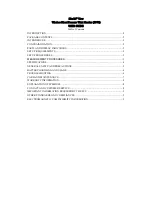
74
Operation
6.2
Tips for a greater range
The
ebike's
range depends on many influencing
factors. A single battery charge may only last
fewer than
12 miles
but much more than
60
is
also possible. There are a few tips which will
generally help you maximize range.
Suspension elements
Only open suspension fork and damper when
necessary on terrain or gravel paths. Block
suspension fork and damper on tarmacked
roads or on hills.
Mileage
The more physical effort the rider makes, the
greater the attainable range is.
Shift down 1 to 2 gears to increase the induced
power and pedalling frequency.
Pedalling frequency
Ride using pedalling frequencies of over
50
revolutions per minute. This optimi
z
es the
electric drive's efficiency.
Avoid pedaling very slowly.
Weight
Minimi
z
e the total weight of
ebike
and
baggage.
Stopping and starting
Ride long distances at a constant speed.
Avoid stopping and starting frequently.
Level of assistance
The higher the selected levels of assistance
are, the shorter the range is.
S
hift
ing
Use a low gear and a low level of assistance on
hills and when setting off.
Switch up a gear depending on the speed and
terrain.
50-80 crank rotations
/minute
are optimal.
Avoid high stress loads on the crank during a
gear change.
Switch gear back in good time, e.g. before
inclines.
Tires
Always select the right
tires
for the surface
type. As a general rule, narrower treads
are
more efficient than wider treads
. L
arger lugs
and
deeper
grooves usually have an
unfavorable effect on energy consumption.
When riding on asphalt, it is important to
always use the maximum permitted
tire
pressure.
When riding off-road on gravel tracks or soft
woodland or meadow soils, it is important to
remember the lower the
tire
pressure is, the
greater the rolling resistance is and thus the
greater electric drive system energy
consumption is.
Rechargeable battery
Electrical resistance increases as the temperature
drops. Battery performance is reduced. As a
result, you should expect the range to be shorter
than normal in winter.
Use a thermal protection sleeve on the battery
in winter.
The range also depends on the battery’s age,
charge level and state of repair.
Maintain the battery and replace older
batteries where necessary.
Summary of Contents for BULLS 650-185
Page 211: ...210 Notes ...
Page 213: ...212 About these operating instructions ...
Page 215: ...214 About these operating instructions ...
Page 217: ...216 About these operating instructions ...
Page 219: ...218 About these operating instructions ...
Page 220: ...219 About these operating instructions ...
Page 221: ...220 About these operating instructions ...
Page 222: ...221 About these operating instructions ...
Page 223: ...222 About these operating instructions ...
Page 224: ...223 Documents 11 4 Charger operating instructions ABCDE ...
Page 225: ...224 Documents F 4A Charger DCG F H A I A J ...
Page 226: ...225 Documents F A I A J DCG F H ...
Page 227: ...226 Documents F DCG F H A I A J ...















































